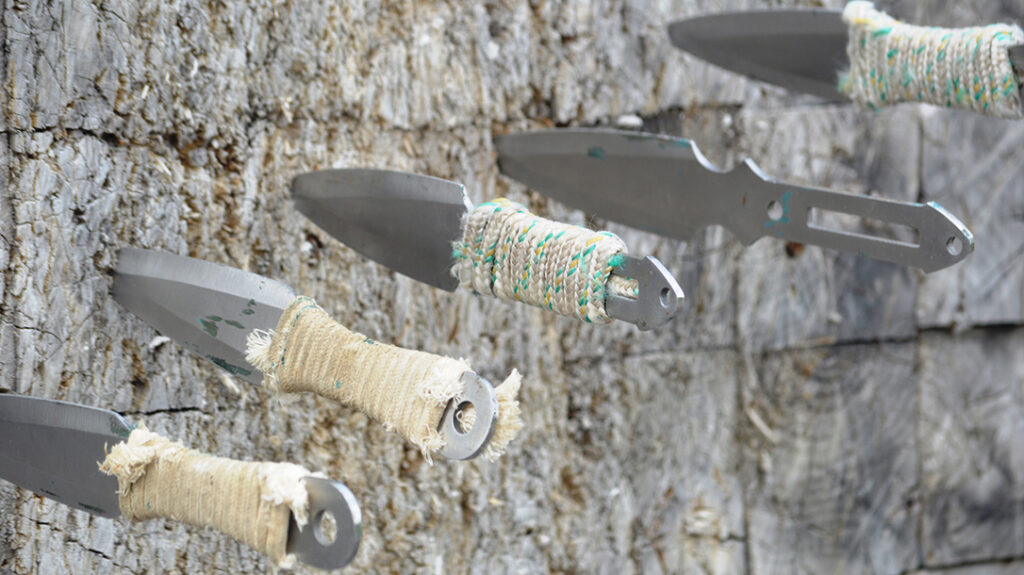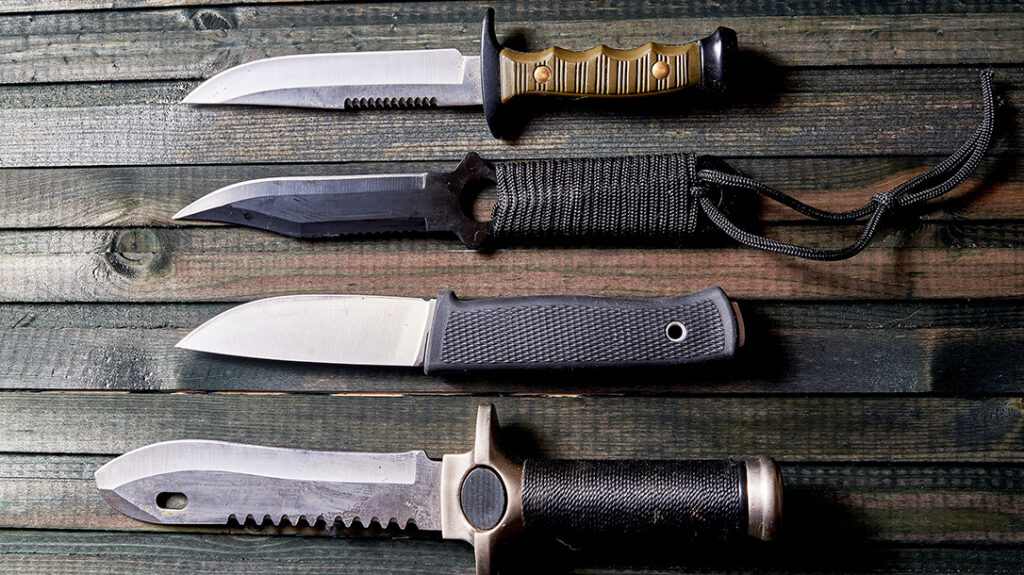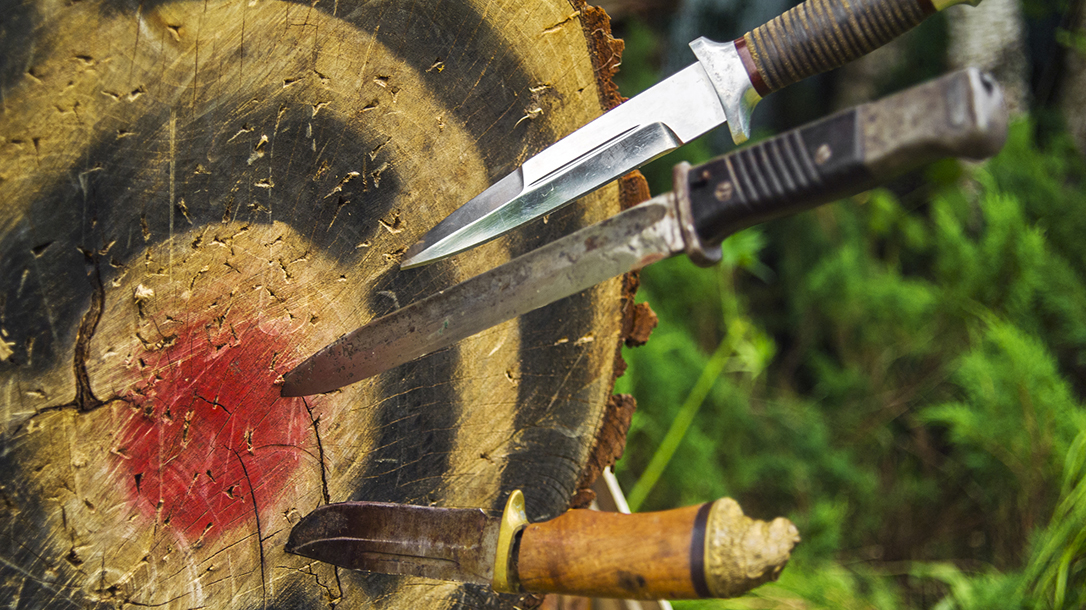I’m sure most people have seen a movie where a knife has been grabbed, thrown, and hit its mark with unbelievable precision by the action star. Many times, it’s just a blur or a quick cut that doesn’t allow you to track the blade on its trajectory. That’s because it’s just a special effect created in post-production. But is it possible in real life to take just about any knife and throw it with similar accuracy? It is, but you need to know some basic knife-throwing fundamentals, along with some intense practicing to achieve your knife-throwing goals. Here’s how to make it happen…
How to Throw Knives: Choose Your Weapon
Now, the stated goal says, “throw any knife”, which is what you’ll be able to do, but first you’ll need to know the different characteristics among knives. These will affect how you throw them. First, the most difficult knives to throw are small, lightweight versions. Lacking any substantial weight, you’ll have a tough time making these rotate and stick firmly into your target. Can it be done though? Of course it can, but wait a bit on the lightweights until you’ve become proficient at the art of throwing. Larger, heavier knives should be your first choice, Mind you, it won’t matter if you opt for a blade-heavy or handle-heavy style, or even an overall balanced knife, because there’s a distinct way to throw each and every one of them.
Get a Grip
The grip is the first important step of proper knife throwing. For a heavy-bladed knife, grip it by the handle. You always want the weighted end thrown first. For heavy-handled knives, grip them by the blade. And if the knife exhibits balance, grip it however you chose. Next, the knife style, whether a single-edge or double-edged, will determine how you hold it. A hammer grip (naturally, like you would hold a hammer) is perfect for throwing double-edged knives (no fear of hurting yourself holding the blade) and works well with blade-heavy styles.
For single-edged, handle-heavy knives, choose a pinch grip. Here, the back of the blade fits into the fleshy part of the hand, with the thumb pressing against the side. Meanwhile, three fingers press against the other side. The pinky is free and the tip is just below the hand level, keeping the tip from harming the thrower. If the knife is blade-heavy and double-edged, use the pinch technique, pressing the knife against the meaty portion of the palm. It should go without saying that no matter the knife and grip, you should be using your dominant hand to throw.
Angle & Turnover
No matter If you hold the knife by the handle or by the blade, you’ll need to get the weapon to rotate in the air before it strikes its target (and hopefully sticks). The number of rotations depends upon the distance you are from the target and where you grip the knife. If held by the blade and you’re close to your target, then a quick, short throw with your wrist bent a s far back as possible to your forearm, will do the trick.
At medium range, you’ll still bend the wrist but less than when at a short distance. Your arm will also assist by bending slightly at the elbow. If far from your target, you won’t need your wrist involved (keep it unbent) and instead focus on a larger arcing throw that allows a slow rotation in the air. This is needed to close the long distance between you and the target.

Proper Stance Matters
While you’re focusing on your wrist and arm, don’t neglect the lower half of your body. Proper stance is key to perfecting your throw and hitting your target. You should always keep your dominant leg back with your weight over it prior to your throw. As you proceed to throw, shift your weight from the back to the front leg while simultaneously swinging your forearm forward. The blade should be released as your body reaches its maximum forward momentum. Lining up your body and keeping your leg, arm, and line of sight all in line will result in a straight throw and help you to strike your target. Throwing the knife like a baseball and tilting the angle of your wrist will disrupt the trajectory and cause you to miss.
Variety: The Spice of Life
In the martial arts world, there is an old saying, “You only can truly say you mastered a technique if you can perform it correctly on everyone in the room.” Well, knife throwing offers a similar mantra. If you can throw any knife, no matter its shape or weight, then you truly understand the fundamentals of knife throwing. Just using traditional throwing knives all the time will not improve your skills with other styles of knives with different types of blades. By varying up your choices, you’ll be able to pick up any knife and innately make it hit its target. Your adjustments will happen in micro-seconds just by observing the knife’s length and feeling its weight in your hand. So, mix it up a bit, and you’ll come out a better knife thrower, guaranteed!

Practice, Practice, Practice
The final tip to successfully throwing just about any style of knife is that you need to practice constantly to become better. Yes, I know, big surprise. Like anything in life that you want to learn, whether it’s a musical instrument, taking up a hobby, or joining a sports team, you need to put in the work to see results, and knife throwing is no different. However, once you dig in deep and commit to learning the proper ways and techniques, you’ll soon be hurling pointed metal like an absolute pro!
Didn’t find what you were looking for?
Read the full article here




